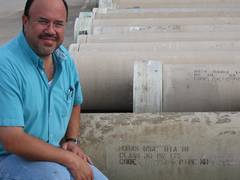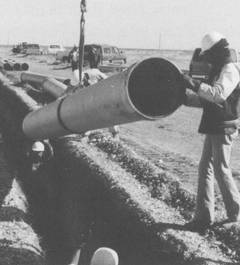20 Years of Reliable Service in Harsh West Texas Environment
Rick Turkopp, Vice President of Engineering for Hobas Pipe USA remembers one of these early installations, “West Texas Water Supply System (WTWSS), which operated near Odessa, Texas, expanded its distribution lines using 18-inch diameter centrifugally cast fiberglass pipes. Two separate lines were included in the project to deliver brackish water, originating from the Capitan Reef, to nearby oil fields for use in secondary recovery processes. Both pipelines utilized minimum pipe classes PN 150 (maximum 150 psi operating pressure), SN 36 (minimum 36 psi pipe stiffness) delivered in 20 foot sections and field assembled with Hobas standard FWC couplings.”
The job was successfully installed and years went by until again the manufacturer heard from the pipeline’s new owner. On June 19, 2009, over 20 years after the original installation, Hobas Pipe USA was contacted by the operations group at Centurion Pipeline L.P. a subsidiary of Occidental Petroleum Corporation. An adjacent pipeline rupture had caused damage to several segments of the existing line and the pipelines owner was in need of replacement pipes. The Hobas manufacturing plant was able to respond quickly. Several segments of pipe were manufactured within days and shipped within a week to the West Texas oilfield location.
Timely reinstatement of the line was critical, as it serves as a main supply line. “The line’s purpose is moving water to sell for makeup for injection,” stated Vidal Rosa, Asst. Manager of Operations, for Centurion Pipeline L.P., who operates the pipeline.
Eighty feet of new 18-inch diameter Hobas pipe was supplied to repair a small portion of the line damaged in the third party incident. “Throughout the process, Hobas was lucky enough to receive some of the over 20-year-old pipe back,” stated Pepe Rodriguez, Quality Control Supervisor and 20-year veteran of Hobas. The Hobas organization is full of long-term employees like Pepe and many were involved with product when the original WTWSS job was manufactured. “We reviewed the files we keep onsite for all manufactured products and we were able to determine that this was one of the first CCFRPM pipes manufactured in the USA back in November of 1987.” It is rare that segments of line are available for testing as most remain in use for their lifetime.
“We (Stork Materials Technology) were hired to evaluate the mechanical properties of the Hobas pipe 21.5 years after the original manufacturing date. We performed a variety of tests in accordance with the ASTM standards for the product. In all cases, the results of these tests exceed the original requirements,” determined Terry Wilt, Metals & Product Testing Department Manager, Stork Materials Technology, Houston.
More importantly, the proof is in the performance.
“When the line was designed, we were told that the Hobas fiberglass pipes were chosen because of their inherent outstanding corrosion resistance,” remembers Turkopp. “The brackish water temperature is normally around 90 to 95° F and is also contaminated with hydrogen sulfide. This corrosive environment has limited the useful lifetime for other pipe materials in the WTWSS to less than 15 years. Past WTWSS installations have included concrete steel cylinder, asbestos cement and steel pipes with various linings and coatings. WTWSS management expects a 50 year or longer service life for the Hobas fiberglass pipes.”
The line was field tested over 20 years ago at 175 psi, without a leak, and was subsequently put into service. Over the years there was little need to monitor the line. It performed well and was, as the saying goes, ‘out of sight — out of mind’.
Onsite operations personnel were also pleased with the pipes behavior. “We have not had any problems; this is our best line for what we use it for,” commented Rosa. “We’ve got 20 miles of it in operation. Line is under pressure at anywhere between 75 and 100 psi.”
“Actually, there haven’t been any problems since the installation of that line – no problems whatsoever until this occurred and this was a third party incident. That’s a good pipe.”



